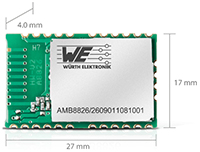By Würth Elektronik EISOS 77

Wurth Electronics’ AMB8826-1 is an extremely power-saving and versatile radio module based on the Texas Instruments system on chip (SoC) CC1310. The integrated firmware supports three operating modes: long range mode, flooding mesh net, as well as the ready-to-go configuration. The hardware offers versatile applications. In addition, the AMB8826 footprint is compatible with Wurth Electronics’ other radio modules in the 169 MHz, 434 MHz, 868 MHz, and 915 MHz frequencies.
In the long-range mode, the total reception sensitivity of the chip of -124 dBm is optimally utilized. This results in a phenomenal link budget of 138 dB, which, together with its narrowband properties, allows a very disturbance-resistant radio transmission with a range of up to 10 km (providing a clear line of sight and a dipole antenna placed at least 6 meters above ground). The wireless data rate at 625 bps is more than twice the rate compared to other long-range systems. Therefore, this mode of operation is particularly suited for transmission of small data packets, such as those of wide sensor networks.
The mesh functionality integrated into the firmware automatically routes messages to the destination address even over large networks. Each network user can act as a forwarding point and at the same time is also accessible as recipient via a separate address. To avoid unnecessary radio traffic, the modules compare incoming radio packets before re-transmitting them. This minimizes network traffic and prevents neighboring repeaters from repeating a telegram twice. Flooding mesh networks are very robust and easy to install. Radio traffic to maintain the network topology, as is the case with other mesh networks, is not required. In addition, no special measures are required to teach or include new nodes in a network. The simple allocation of a destination address for each node is sufficient to build up a mesh network.
The AMB8826-1 is pre-configured so that data can be sent directly from one module to another. The command interface provides easy-to-use commands for sending data and editing parameters. Even in the standard configuration, the module supports a wide range of functions and network topologies. Broadcasts, peer-to-peer, and star connections are possible. Addressing up to 3 bytes allows the creation of 255 networks each with up to 65535 nodes. A total of 40 channels can be selected from within the 868 MHz frequency band, which means that neighboring radio networks can also be physically separated from each other. In addition, the channel selection offers the possibility to move between 0.1% and 10% in duty cycle options (the duty cycle defines the maximum duration for which a frequency may be occupied per hour).
The interfacing of the radio module to the host system takes place via UART with data rates of up to 115.2 kBaud. Further pins are available for data flow control as well as for wake-up control. Numerous freely configurable GPIO and a JTAG interface make the AMB8826-1 very versatile. Even complex applications, in which the module via further firmware adopts additional tasks, are achievable.
The radio module available in tape and reel packaging is suited for automatic assembly